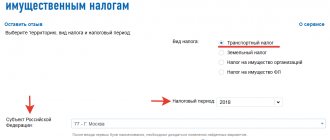One of the most controversial issues in modern taxation in Russia is the payment of transport tax. Planned as a temporary tax, this tax has become a permanent tax and has been representing an additional tax burden on citizens for several years now. Therefore, issues related to the procedure for its calculation and payment do not lose their relevance.
What is a transport tax and who does it apply to?
Transport tax is a fee that must be paid annually by every citizen of the Russian Federation who owns a car.
The basis for charging this tax is the need to support the vehicle fleet. This tax is considered as a target tax: all funds collected from the state budget are redirected to specialized services that are engaged in the repair and construction of roads, carrying out improvement work in various areas, including roadside areas.
Those who are liable to pay vehicle tax include the owners of any vehicle, including land, water or air.
This tax refers to regional fees. Its size and payment procedure directly depend on the region in which the vehicle was registered. Municipal authorities of each region have the authority to set their own tariffs, on the basis of which this fee for motorists is calculated. Also, as a general rule, the transport tax on a car depends on what characteristics the car has.
Plays his role:
- weight;
- engine power;
- age.
In addition, if we talk about transport tax in 2021, the class of the car has begun to be taken into account.
It should be noted that, according to current legislation, representatives of the tax authority are required to calculate the amount of transport tax in each specific case. However, no one is immune from mistakes, so it is recommended to double-check the amount issued yourself. The tax is calculated using the following formula: the number of horsepower of a car engine is multiplied by the tax rate accepted in the corresponding region. If the use of the car is less than one year due to its purchase or sale, then the number of months is also taken into account in the calculation.
To simplify the calculations, use a special tax calculator, which can be easily found on the Internet. It works on the following principle: you enter data on your vehicle and receive an approximate amount that must be paid as transport tax. As for how much the transport tax is for legal entities, this issue should be dealt with by the organization’s accountant.
Who doesn't pay car tax: regional legislation
There is no nationwide list of preferential categories of citizens, so in each case one has to ask whether a person has the right to certain financial benefits. The list of those who have the right to legally not pay transport tax varies greatly in individual regions of the Federation, as well as the applicable tax rate.
Tax rate options for beneficiaries
Taxpayers in various regions are in an unequal position, since the list of beneficiaries is prescribed in the local “Law on Transport”. According to this document, the same category of taxpayers, depending on the region of residence, may belong to the following groups:
- Having 100% discount. This group includes those who do not have to pay transport tax at all. Local law always regulates the specific characteristics of the vehicle: country of manufacture, year of manufacture, engine power. If the engine power exceeds the established limit, you will have to pay tax on the excess.
- Having a partial benefit. The rate can be 50 or 70%, while the upper limit on the engine power of a car or motor vehicle is also regulated. Depending on the region, the limit for cars is set at 100, 150, and sometimes even 200 hp, and for motorcycles - at 30, 35, 40 or 45 hp.
- Fully paying TN. Taxation standards in certain regions are especially strict, as a result of which persons registered there cannot count on relief from the state.
Not all property
Owners of two or more vehicles are allowed to receive a preferential rate on only one of them, and only within the established limits. Extra horsepower or a second car will have to be paid at full rate even for those who are not subject to transport tax.
Individuals: common benefit categories
A specific list of those who are not subject to the transport tax is prescribed in the local “Transport Law” of the subject in which the owner is registered. This is an important point, since the place where the car is registered does not matter in this case. Beneficiaries may include:
- veterans, disabled people, participants of the Second World War, UBI;
- prisoners of concentration camps during World War II;
- Veterans of Labor;
- Knights of the Order of Glory (usually specifying the degree);
- disabled people of group 1 or 2;
- persons holding the title of Hero of the Soviet Union and the Russian Federation;
- pensioners who, in some regions, have just completed their work experience in the far north;
- large family (only one parent receives a preferential rate);
- liquidators of man-made disasters accompanied by radiation, incl. Chernobyl accidents;
- persons who received radiation damage during nuclear weapons testing;
- families raising a disabled child (only one parent receives a preferential rate);
- owners of vehicles with an engine less than 70 hp.
Exact information about who does not pay vehicle tax and who receives a preferential rate must be clarified in the legislative framework of a particular subject of the Russian Federation. This article describes in detail the features of calculating TN for pensioners in Moscow and Moscow Region. The paradox of the situation is that a pensioner in the Tver region will pay on a general basis, while in the Ryazan region he will be completely exempt from payment.
Organizations exempt from labor tax at the regional level
Local authorities independently form a list of organizations that are exempt from this type of tax or receive a preferential rate on it. It is worth contacting your local tax office for clarification if your company falls under one of the following definitions:
- Organizations providing social support to disabled people on a non-profit basis.
- Companies specializing in the transportation of passengers, except taxi services.
- Special organizations purposes of state and non-state forms of ownership: Ministry of Emergency Situations, ambulance, etc.
- Budgetary institutions that serve preschool institutions, schools, orphanages, etc.
- Ground and air official transport used by government officials.
- Transport owned by religious organizations.
- Companies whose activities contribute to regional development.
- Road equipment and vehicles used during road work.
Trust the papers
You should not rely on the oral response of any official, since it has no legal force. To find out exactly in which case transport tax is not paid, submit a written request to the tax office or study local laws yourself.
How is tax paid?
Payment of transport tax is mandatory for all vehicle owners. However, it is important to emphasize that there is a category of citizens who can contact the tax office to receive benefits. Their list is established independently in each region.
As an example, let’s take the benefits that the Moscow region imposes on transport taxes in 2021. According to the current law, public organizations whose members are disabled people are exempt from paying this tax.
In relation to individuals, to citizens who may not pay this fee
, relate:
- awarded the Order of Glory or Hero of the Russian Federation or the USSR;
- victims of the accident at the Chernobyl nuclear power plant;
- those who took part in the Second World War;
- with disabilities (except for the third group - they receive a 50% discount).
Also, certain benefits are established for cars whose engine power is less than a certain limit.
Thus, in order to find out the tariffs for calculating transport tax and the likelihood of receiving benefits, you need to refer to regional legislation. The calculation of the amount of transport tax required for payment for individuals is carried out by the tax office, which is reported in a written notification sent.
Who is exempt from paying the transport tax?
Category 1. Preferential categories of the population. Federal legislation includes disabled people of groups I and II; parents of large families with children of three or more are included in the list, as well as citizens serving in the military, and veterans of the Great Patriotic War, and liquidators of accidents at nuclear power plants (in Chernobyl, on "Mayak"), etc.
In the constituent entities of the federation, the list of categories of beneficiaries varies: for example, in the Kemerovo region, in relation to one passenger vehicle with an engine power of up to 250 hp. old-age pensioners, disabled people of the third group, various public organizations, and in Yaroslavl - low-income families with a large number of children are exempt from paying the fee; in Karelia, to obtain an exemption, you must be a social or military pensioner, and in Tomsk, you must be the owner of a pneumatic or tracked vehicle. To find out whether the owner of the car is among the beneficiaries, you need to select the desired region and city on the website of the Federal Tax Service.
Preferential categories for transport tax (Lipetsk region)
Category 2. Owners of the following vehicles (their complete list is presented in Article 358 of the Tax Code of the Russian Federation (Part 2)) - rowing boats; “passenger cars” intended for disabled people with an engine up to 100 hp; sea or river vessels used for fishing; registered agricultural machinery (tractors, cattle and milk tankers, etc.); equipment involved in road repairs.
Category 3. Motorists who transport disabled people.
Category 4. Owners of heavy-duty equipment: tax exemption is valid from 2015 to 2021. The benefit applies to both individuals and organizations. It covers vehicles weighing 12 tons and heavier that are included in the tax register of equipment that causes damage to roads, while the owners of such vehicles pay approved contributions, the amount of which for the tax period must be greater than the accrued tax.
Category 5. A foreigner is the owner of a car that has license plates from another country (i.e. the car is not registered in Russia). This situation is possible for those residents of our state who have a residence permit or other citizenship.
Category 6. Taxpayers who own equipment whose engine power does not exceed 70 horsepower (information is indicated in the vehicle passport).
Category 7. Owner of a leased vehicle (the fee is paid by the lessor company, which owns the equipment during the term of the contract). However, it is worth remembering that the transport tax is most likely already included in the amount of each leasing payment, and with interest.
Category 8. Citizen using a car by proxy. Exception: if the tax office is notified of the fact of the transfer and the corresponding permission, then the obligation to pay the fee is transferred to the trustee.
If a car owner falls into the category of beneficiaries, then you need to fill out an application for tax exemption and take it to the tax office at the place of registration of the owner. You must notify the Federal Tax Service about the availability of the benefit before the first of April next year.
Video - Who has benefits when paying transport tax?
How to pay transport tax - main methods
The rarity of the need to pay transport tax and the constantly changing deadlines that are established at the legislative level can lead to the fact that the need to pay is remembered literally on the last day, and late in the evening, when neither bank branches nor the post office are open. In this case, the only possible (and, frankly, the most convenient and fastest) is the method according to which payment of transport tax is made via the Internet. There are a number of sites you can use for this.
Distribution of tax notices on transport tax
Legal entities do not receive any notifications from the tax office regarding the payment of transport tax. They act in accordance with regional legislation, independently calculate the amount, submit a declaration and make payments one time or in four installments (advance payments). Accordingly, the problem of delayed tax notifications does not exist for them, and late payment of taxes is solely their own mistake.
The calculation of the amount of transport tax for individuals is carried out by the regional Federal Tax Service, which uses open registration databases of the State Traffic Safety Inspectorate. A private car owner can only receive a notification and pay the tax before December 1.
Typically, tax inspectors create calculations and begin sending out notifications about the need to pay transport tax at the end of summer. In the letter, the taxpayer receives the notification itself and a receipt for payment with the tax amount already indicated and the payer’s details.
The car owner can pay the tax in cash at the bank's cash desk, by card at an ATM or online - through online banking, the Federal Tax Service and State Services portals, electronic money services Yandex.Money and WebMoney.
Important! The deadline for receiving a tax notice is November 1, after which you will have exactly one month to make your tax payment.
However, sometimes the notification does not arrive, and car owners face a problem: how to pay the tax without a receipt? Is it possible not to pay without a payment document? What to do if the receipt did not arrive or is late?
How to find out your debt
The easiest way to find out the transport tax debt is to receive a receipt through the postal service, which indicates the amount to be paid and payment details, and all that remains is to pay it at the bank. However, in case of loss of a receipt or other circumstances due to which you did not receive a receipt, you can resort to other methods, each of which we will consider in more detail.
Independently calculating the approximate amount of tax payable is not the most effective way, although citizens resort to it, due to the need to clarify the coefficients for your region, as well as the dependence of the amount on the engine size and year of manufacture of the car.
How to check the calculation
Each citizen can independently allocate the amount of tax. To do this you need to know the calculation formula:
payment = tax rate X horsepower X multiplying factor
If ownership of the vehicle was less than a full year, then the payment amount must be divided by twelve and multiplied by the number of full months of ownership of the property.
For example, the tax on a Toyota Land Cruiser 200, produced in 2021, with a capacity of 318 horsepower, costing 3,800,000 rubles, registered in the Kemerovo region, where the rate is set at 135 rubles, will be: 135x318x1.1=47,223 rubles
Transport tax benefits – not only for pensioners?
The example shows a calculation using the rate established in Kuzbass. The following tariffs apply for passenger cars in this territory:
| Engine horsepower | Tax rate for each horsepower in rubles |
| Up to 80 | 5.5 |
| From 80 to 100 | 8 |
| From 100 to 150 | 14 |
| From 150 to 200 | 45 |
| From 200 to 250 | 68 |
| Over 250 | 135 |
If you own the car for less than a full year, say 2 months, then the amount will be as follows: 47223 / 12 X 2 = 7870.5 rubles.
By TIN
If you have the Internet, you can find out the amount of debt through your TIN.
To do this you need:
- Go to the website of the Federal Tax Service at the address: nalog.ru, where we enter the login and password previously received from the tax office to enter your account. Please note that in this case your TIN is entered as a login to log into your account.
- Go to the “Objects” tab. In this menu, the objects of your property available at your disposal are available.
- The menu for the amount of tax to be paid is located on the line “accrued”
- Carefully read the tax amount, as well as information on the property - if the data does not match, you should contact the Federal Tax Service.
- To pay, click “Pay”, and the system will offer you available payment options, with the possibility of partial payment, and automatic generation of details. Please note that the system displays by default the tax amounts payable for all types of your property. To select the object for which we pay, check the boxes.
Why the tax on the car does not arrive and what to do in this case
There may be several reasons why the car tax is not received. According to statistics, the most common is the need to revise the amount accrued for payment due to the discovery by employees of the competent authorities of inaccuracies in the calculation. Sometimes the absence of a receipt in the mailbox can be caused by the absent-mindedness of the vehicle owner, who forgot to notify the relevant authorities about the change of residence.
To avoid accrual of penalties and fines for non-payment of transport tax in the absence of a receipt, you must personally contact the tax office at your place of registration and inquire about the reason for the delay. When submitting the corresponding application, tax officials must provide the applicant with a receipt for payment or indicate the amount of tax to be paid.
On the State Services website
Another reliable source of information about the amount of tax payable is the State Services website at gosuslugi.ru.
To clarify the amount:
- Log in to your personal account by entering your login and password.
- Click on the public services menu at the top of the window.
- Since our goal is to pay taxes, let’s turn to the “Checking tax debts” menu.
- Click get a service, and the system will check the amount of debt using the TIN you previously entered (otherwise this cannot be done).
- When you display the result, you can view the amount or pay online.
Deadline for payment of transport tax
The period for which transport tax is paid is one calendar year. The payer must be notified in writing by the tax authority of the payment deadline.
However, the changes that came into force in 2015 established that if the taxpayer does not receive the corresponding notification, he must independently contact the tax authority at his place of residence before December 31 of the year following the one for which he is due. tax will be charged.
The tax payment deadline from the current year has been postponed to December 1 of the next year.
.
In other words, if you own a vehicle, you must pay the vehicle tax for 2021 by December 1
. If the car becomes a property within a year, the payment is calculated in proportion to the time the citizen is the car owner.
Payment period
All provisions of transport taxation are regulated by Chapter 28 of the Tax Code of the Russian Federation. Since this type of tax is a regional deduction, it is within the competence of local authorities, whose representatives are responsible for calculating rates and compiling a list of persons paying tax on preferential terms. Territorial reference determines different payment amounts depending on the region of registration of the car. The basis for calculations is information received by the Federal Tax Service from regional branches of the State Traffic Safety Inspectorate in the form of data on the registration of new vehicles, concluded sales contracts or deregistration of a car.
Main changes in transport tax in 2021
The entities on which the vehicle is registered are required to pay car tax, in particular:
- automobile;
- airplane;
- yacht;
- bus;
- powerboat;
- snowmobile;
- motorbike;
- scooter;
- jet ski;
- sailing vessel;
- boat
All payments accrued for the previous year must be paid by the end of the current year.
According to the Tax Code of the Russian Federation, a notification and receipt of payment must be sent to the owner of the car no later than 1 month before the deadline for payment.
The deadline for payment of transport tax for 2021 has been extended for individuals: if in 2015 the fee had to be paid before 01.10., then in 2016 the payment can be made until 01.12 of the calendar year following the reporting year. Thus, payment for the transport fee for 2021 must be made before December 1, 2017.
Tax is imposed on every car registered with the relevant authorities. This condition dictates the following rule: if the owner does not use the vehicle he owns, the owner of the car must pay tax in any case. This financial bondage can only be avoided by deregistering the car.
For organizations, a different payment period is provided. The tax period, like for individuals, is a calendar year, but the scope of the reporting period is shifted to the 1st quarter of the year following the reporting one. The toll payment deadline must not be set later than the deadline for submitting the annual declaration.
Legal entities had to submit reports for 2021 to the tax office before 02/01/2017. Even if the company ceased to exist during the tax period, it must transfer transport tax to the treasury within 3 months from the date of its liquidation.
If the tax payment date falls on a weekend, it is postponed to the next working day. For organizations, quarterly payment is provided through advance payments. The taxpayer must make the payment within 1 month following the reporting period.
For example, in the 1st quarter, the final date for transferring funds to the treasury falls on April 30, then it falls on July 31, October 30 and March 31 of the next year. The timing for the transfer of advance toll payments is usually identical in all regions. This option is available only to legal entities; individuals make payments once a year.
Starting from 2015, when calculating the amount of the advance payment, it is necessary to apply a multiplying factor.
For legal entities
Separately, it is worth noting the procedure by which the deadline for payment of transport tax by legal entities is calculated. If a tax period is established for an organization, it must pay advance payments. The deadline for making this payment is set for the last day of the month following the reporting month. The deadline for final tax payment is established at the legislative level, but cannot be made later than February 1 of the year following the reporting tax period.
If the notification does not arrive on time
Failure to receive a letter from the tax office with a receipt does not exempt you from liability. It does not matter at all whether the notice was delivered to you, the fee must be paid without fail.
What to do if a tax has arrived on a sold car - how to correct the situation?
The notice is not sent to citizens for whom the benefit applies, and payment is not required.
What to do if the reporting period is close to the end, but there is no receipt:
- It is necessary to visit the tax office, report the absence of notification, at the place of residence or at the place of registration of the car. This information can also be sent through the taxpayer’s personal account electronically (if you visit in person, you will be given a receipt by the inspectorate).
- Every citizen is obliged to notify the Federal Tax Service about the registration of a taxable object; in cases of ownership of property and non-payment, due to failure to mention it, the inspectorate reserves the right to recover payment for the previous three years, but not more than the period of ownership (clause 2 of Article 52 of the Tax Code of the Russian Federation ).
Increasing coefficient for transport tax - will you have to pay triple for a Bentley?
If the tax on the car does not arrive, you may not have reported the presence of a taxable item. What should be corrected, since Art. 23 of the Tax Code of the Russian Federation provides for a fine of 20% of the tax for this silence.









